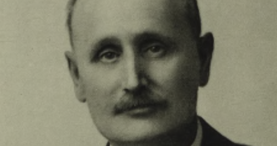
Arthur Chattock (1860–1934) was a British physicist who carried out telepathy experiments, now of mainly historical interest.
Life and Career
Arthur Prince Chattock was born on 14 August 1860 at Solihull, Warwickshire, UK. He studied engineering and physics at University College, London, then worked briefly as an electrical engineer for Siemens. In 1885 he was appointed demonstrator in physics at UC, Bristol. From 1887 to 1889 he worked as assistant lecturer to Oliver Lodge in Liverpool. In February 1888 he participated in key experiments contributing to the understanding of radio waves.
Between 1889 and 1909, Chattock was lecturer on physics and professor of physics and electrotechnology at Bristol. Changes at UC Bristol prompted him to leave his chair in physics in 1891. In 1911 that same institution – now the University of Bristol – awarded him an honorary DSc degree, and shortly afterwards the title of emeritus professor. During World War I he spent most of his time as a chicken farmer at Crowcombe, Somerset, doing extensive research on poultry.
He resumed his university teaching in 1919, and a year later was made a fellow of the Royal Society.
Shortly before his retirement (1924), Chattock carried out definitive experiments on the gyromagnetic ratio of iron. In recognition of his work the university endowed a permanent Chattock Research Studentship in the Wills Physical Laboratory.1
Chattock died on 1 July 1934 at his home in Clifton, Bristol.
Psychical Research
Chattock became acquainted with Sir Oliver at University College, London and the two corresponded extensively about electrical physics. In the course of this, Chattock learned about Lodge’s interests in telepathy and spiritualism, which he began to share. He joined the Society for Psychical Research in 1890, making frequent donations and giving public lectures.2
Telepathy Experiments
In September 1897 at Harrow, London, Chattock conducted informal experiments with RC Clinker and EB Wedmore, former students of his. Clinker and Chattock acted as ‘senders’ and Wedmore as ‘receiver’ (referred to in the report respectively as ‘agent’ and ‘percipient’, the terms then in use).
Wedmore sat about three yards from the senders. Seven trials were made, in which it was agreed what type of image or idea would be sent.3 The first image, a geometrical figure, was exactly reproduced, and correspondences were observed in some others.
Later experiments were carried out over a long distance, with Chattock in Bristol and the students in London. However, these failed, and Chattock speculated that proximity was required (a notion abundantly disproved by other experiments), since participants needed to be in a particular condition of mind. He wrote:
[I]t occurs to me that the percipient should be in a partially dazed state. In taking long sets of readings during which one gets into a sort of vacant condition, I seem often able to anticipate what my assistant is going to say. Is there any convenient way of keeping oneself in such a condition? I thought of watching a slowly revolving disc.4
He also concluded that the spontaneous nature of the experiments together with a carefree approach helped facilitate good results (a conclusion widely reached by telepathy researchers).
[I]t was quite a sudden thought that we should try thought-transference experiments. To this, and to the fact that we had become socially tuned with much talking and laughing, I fancy what little success we had is due. It has so often happened that the first one or two trials in experiments of this kind show transference and then fail. One gets self-conscious and excited …5
Chattock came to believe that telepathy was the results of some type of electromagnetic wave most likely found in the realm of physics,6 an idea which today few parapsychologists support.
Chattock's approach was contested by other researchers, who objected to letting the percipient know beforehand what type of thing was going to be written or drawn7 and who opposed physical proximity, on the grounds that the percipient can develop anxiety regarding the limits of the agent’s patience and be distracted in other ways.8
Roberto R Narváez
Literature
Anon. (1934a). Obituary. Journal of the Society for Psychical Research 28, 278-79.
Anon. (1934b). Obituary. Nature. July 7, 15-16.
Chattock, A.P. (1898). Experiments in thought-transference. Journal of the Society for Psychical Research 8, 302-7.
Chattock, A.P. (1899). Science and ghosts. The Magnet (University College, Bristol) 1/5, 122-38; 1/6, 175-82.
Bennett, E. (1909). Psychic Phenomena. A Brief Account of the Psychical Manifestations Observed in Psychical Rsearch [foreword by Oliver Lodge]. New York: Brentano’s.
Glardon, A. (1899). Experiments in thought-transference. Journal of the Society for Psychical Research 9, 9-11.
Noakes, R. (2019). Physics and Psychics. The Occult and the Sciences in Modern Britain. Cambridge, UK: Cambridge University Press.
Tyndall, A.M. (1932-35). Arthur Prince Chattock, 1860-1934. Obituary Notices of Fellows of the Royal Society 1, 293-98.
Usher, F.L., & Burt, F.P. (1909). Thought transference. Annals of Psychical Science 52/8, October-December, 561-600.
Endnotes
- 1. Tyndall (1932-35), 294.
- 2. Noakes (2019), 108.; Anon (1934a), 278.
- 3. Chattock (1898), 303.
- 4. Chattock (1898), 303.
- 5. Chattock (1898), 303.
- 6. Anon (1934a), 279; Bennett (1909), 106-8. The latter contains a list of pioneering experiments carried out prior to Chattock’s.
- 7. Glardon (1899).
- 8. Usher & Burt (1909), 562-23; this article contains many graphic materials very similar to those in Chattock’s reports.

